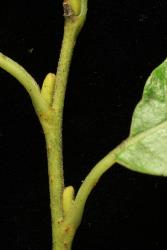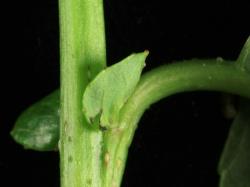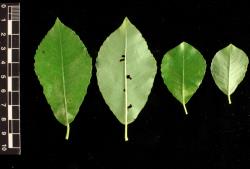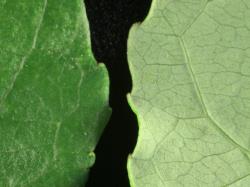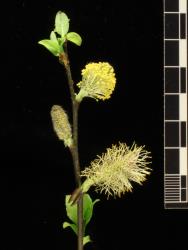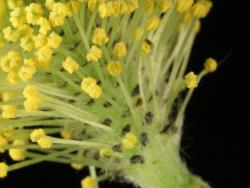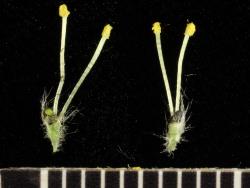Wood ridges sparse and short. Current year's branchlets moderately densely tomentose, hairs persisting for the current year, green to yellow-green. Year-old branchlets light olive (UCL106), glabrous or small amounts of tomentum remaining, 2.7–4.7 mm diameter. Flower bud scales 5.0 mm long, 4.0 mm wide, 2.8 mm deep, ovoid, with angles, strong yellowish brown (UCL74), glabrous. Leaves alternate. Stipule not persisting, 3 mm long, ovate. Petiole 10–13 mm long, sparsely tomentose, adaxial groove absent, glands absent, base of petiole not expanded, yellow-green. Emerging leaves green. Proximal leaves toothed. Leaf lamina 73–90 mm long, 42–50 mm wide, length to width ratio 1.73–1.8:1, elliptic to obovate; base rounded to truncate; apex narrowly acute to obtuse, acuminate; leaf galls absent; margins serrate, slightly undulate, revolute in the sinuses; upper lamina surface smooth, medium glossy, glabrous, stomata absent; lower lamina surface midvein and side-veins raised, distinctly glaucous, glabrous, except for sparsely long-silky hairs on the midvein. Catkins male, emergence coetaneous with leaves. Flowering branch 18–26 mm long, with 3 cataphylls below the catkin. Male catkin 13–17 mm long, 5–14 mm diameter; catkin rachis slightly visible between flowers. Flower bract 1.7 mm long, 0.6 mm wide, black in the upper third, hyaline below, flat, long-silky hairs moderately dense on both surfaces and margins. Male nectary 1, 0.58 mm long, 0.56 mm wide, yellow-green. Stamens 2, filaments free, hairs absent; anthers 0.64–0.66 mm long, yellow, very slightly tinted red at anther apex.
Leaves are elliptic to obovate, 73–90 mm long and 42–50 mm wide. Emerging leaves in spring have obvious glands like those of S. pentandra on the leaf base serrations, and have brown hairs mixed with silver hairs. Mature leaves are glabrous, glaucous below, stomata are absent from the upper leaf surface. Leaves are slightly undulate, serrate, with margins finely revolute between the serrations. Stipules do not persist and when present are small and ovate. Young branchlets are sparsely tomentose with hairs not persisting. Male catkins are short, 13–17 mm long, on a very short stalk and emerge coetaneously with leaves. Anthers are slightly red-tinted, and flower bracts bicoloured (black in distal third, sometimes with red between that and the proximal hyaline portion).
This species is a southern extension into Italy of the highly variable Central European species Salix myrsinifolia. Similar to S. aegyptiaca × S. caprea in size and obovateness of the leaves, veins raised on the lower leaf surface, the leaf apex obtuse, the base of the lamina truncate, and the leaf margin revolute. New Zealand material of S. apennina has hairs present on young branchlets and young leaves, especially on the petiole and upper surface midvein, and so differs very little in this respect from S. aegyptiaca × S. caprea. When catkins are absent, reliance must be placed on leaf size: mature leaves of S. apennina are only 33–41 mm wide versus 57–69 mm wide in S. aegyptiaca × S. caprea, and those of S. apennina are invariably glaucous below whereas those of S. aegyptiaca × S. caprea are glaucous below only when young. Also, flowering in S. apennina is a month or more later (September rather than July), and the mixed sexuality of catkins and flowers in the S. aegyptiaca hybrid is absent from S. apennina.
Known only from the Aokautere national collection as PN710, a clone sent by J. Chmelar of Czechoslovakia in 1979.
First collection: CHR 639254, L. Newstrom-Lloyd, M. Gabarret, B. Polturat, 6 September 2014, Aokautere.
First publication: This publication.
Flowering: Throughout September.
Hexaploid, 2n = 114 (CCDB based on two counts). Flow cytometry of PN710 indicates this clone is provisionally hexaploid, consistent with the two published chromosome counts and valuable confirmation that PN710 is indeed Salix apennina.



